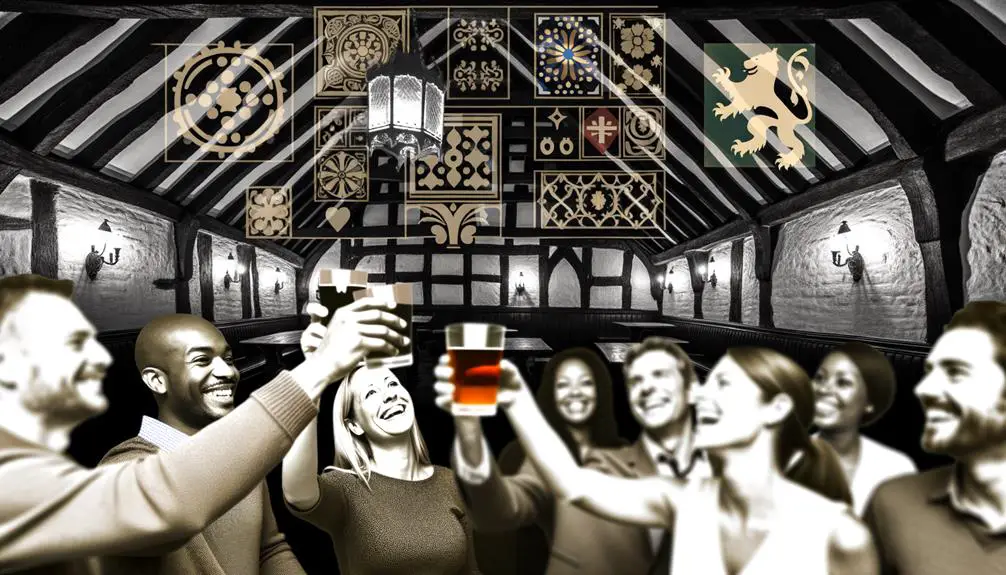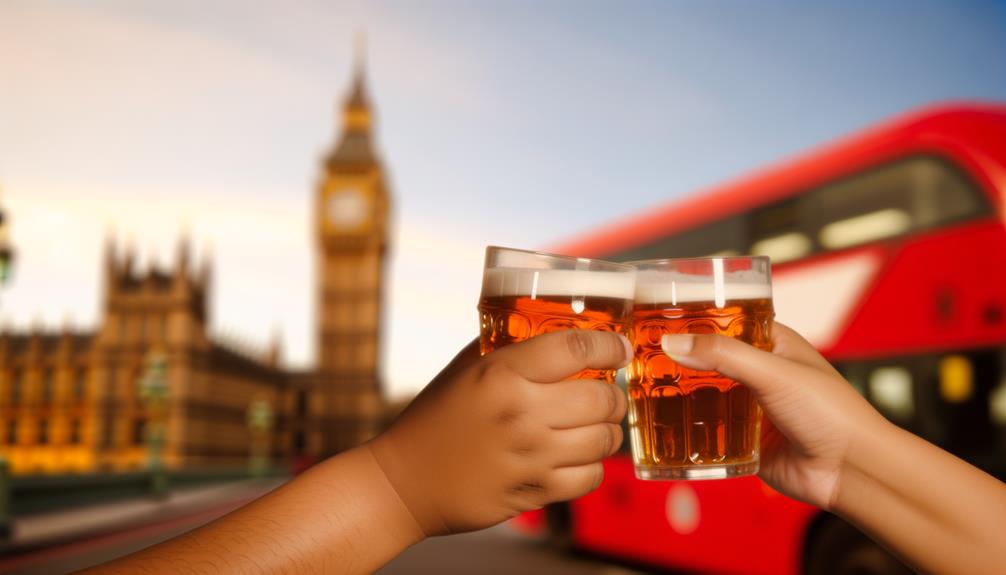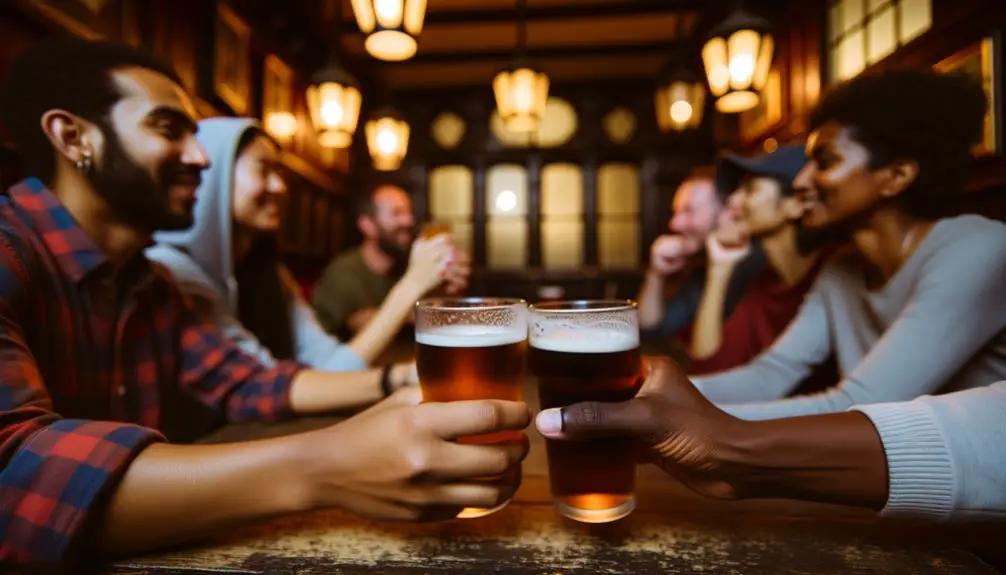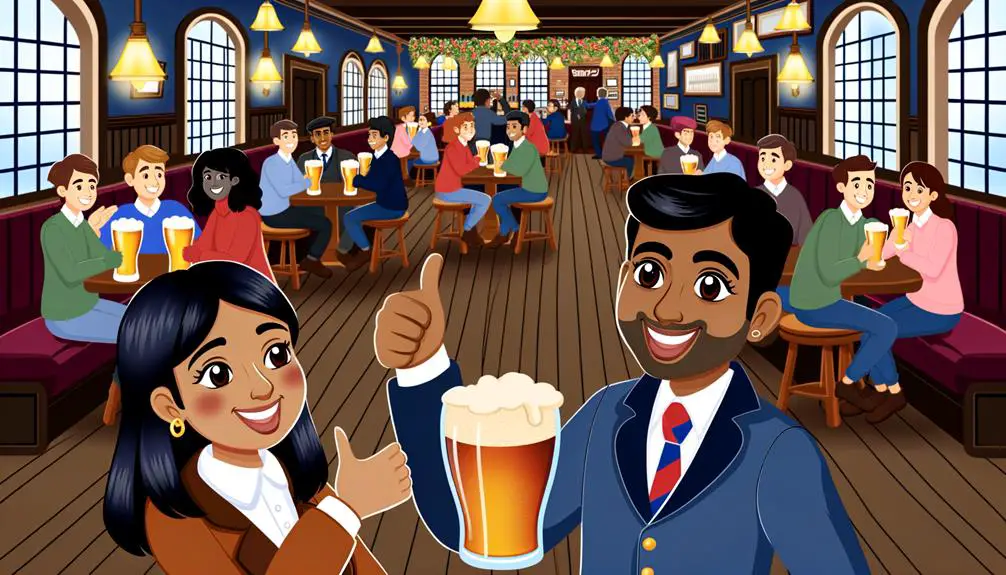In British slang, 'cheers' isn't just about toasting with a drink. It's a multifaceted term that embodies a mix of gratitude, farewells, and agreements. Its origins trace back to the Old French 'chiere', evolving substantially over centuries. Now, in casual to formal settings, you'll hear it as a versatile expression of thanks, a casual goodbye, or to signal agreement. This linguistic adaptability showcases its deep integration into both social norms and individual interactions across British society. The term's relational and emotional dimensions underscore its significance in establishing connections and expressing shared understandings. Unpacking its layered meanings reveals the richness of its cultural nuances.
Key Takeaways
- 'Cheers' in British slang primarily expresses gratitude, akin to saying 'thank you'.
- It is used informally to signify agreement or acknowledgment in conversations.
- The term can also serve as a casual farewell, similar to 'goodbye'.
- In social settings, 'cheers' is often raised as a toast during drinking.
- Its versatility allows it to fit both casual and formal contexts, reflecting its deep integration into British culture.
Origins of 'Cheers'

The term 'cheers' traces back to the late 14th century, originating from the Old French word 'chiere', which means 'face' or 'expression', thereby encapsulating a gesture of goodwill or celebration. This etymological root provides insight into the linguistic evolution of 'cheers' as it morphed from a physical manifestation of emotion to a verbal expression of good wishes. Through scholarly analysis, it's evident that 'cheers' underwent a significant transformation, adapting to the socio-linguistic contexts of varying eras. This adaptation was not confined to the British Isles; 'cheers' experienced global adaptations, showcasing the interconnectedness of cultures and languages.
In examining the linguistic evolution of 'cheers', one must consider the role of cultural exchange in its proliferation. As English speakers traveled and colonized, they brought with them their language and customs, including the expression 'cheers'. Consequently, 'cheers' was assimilated into various cultures, each adapting it to fit their linguistic and social norms. This global adoption and adaptation underscore the dynamism of language, illustrating how expressions evolve and integrate into the lexicon of diverse societies, highlighting the intricate relationship between language, culture, and social interaction.
Toasting With 'Cheers'
Having explored the origins and global spread of 'cheers', let's examine its role in the act of toasting, a practice steeped in tradition and social significance. The utterance of 'cheers' during toasts is not merely a casual expression; it embodies a rich tapestry of drinking etiquette and cultural nuances. This tradition, which varies considerably across cultures, hinges on the communal acknowledgment of a moment, celebration, or shared sentiment.
| Culture | Significance of 'Cheers' in Toasting |
|---|---|
| British | Marks respect and camaraderie among drinkers; often accompanied by eye contact and a slight nod. |
| Japanese | 'Kanpai' (similar to 'cheers') emphasizes group harmony and respect; avoiding eye contact is considered polite. |
| German | 'Prost' (equivalent to 'cheers') is a salute to health and well-being, with a mandatory eye contact to prevent seven years of bad luck. |
In analyzing these cultural differences, it's clear that while the act of saying 'cheers' before drinking is universally recognized, its execution and the values it signifies vary. This variation underscores the importance of understanding and respecting drinking etiquette when engaging in social drinking across different cultural contexts.
'Cheers' as Thank You

In addition to its role in toasting, 'cheers' serves as an expression of gratitude, reflecting a nuanced understanding of social interactions within British culture. This versatile term embodies a spectrum of politeness levels, adapting seamlessly to various social contexts. When you utilize 'cheers' to express thanks, you're engaging in a practice that underscores the subtleties of British etiquette. This usage transcends mere acknowledgment, embedding itself in the fabric of everyday communication.
The deployment of 'cheers' as a token of appreciation signals a casual yet sincere gesture of gratitude. It's this very casualness that imbues the expression with its charm, allowing it to occupy a unique space within the hierarchy of politeness levels. You'll find that its application ranges from thanking a bus driver to acknowledging a colleague's assistance. Each instance reflects a calibrated measure of warmth and informality, attuned to the specifics of the interaction.
Gratitude nuances in British culture are artfully captured by 'cheers'. Its adaptability highlights an intuitive grasp of context, distinguishing between perfunctory politeness and genuine thanks. For you, understanding when and how to use 'cheers' can enrich your interactions, providing a window into the complexities of British communicative norms.
Bidding Farewell
Why does the term 'cheers' also serve as an effective farewell, you might wonder? The answer lies in the evolution of social interactions and the simplicity desired in departure expressions. 'Cheers' as a farewell is not just a word; it's an encapsulation of good wishes, akin to saying 'best wishes' or 'take care' in a more succinct manner. This usage reflects a broader shift in farewell traditions, prioritizing brevity and warmth.
| Farewell Traditions | Departure Expressions | 'Cheers' as Farewell |
|---|---|---|
| Historical context | 'Goodbye' evolution | Modern simplicity |
| Cultural significance | Emotional resonance | Friendly disposition |
| Social interactions | Verbal efficiency | Universal acceptance |
This table illustrates the evolution from formal, lengthy goodbyes to the more casual and universally understood 'cheers'. It underscores the importance of cultural significance and social interactions in shaping departure expressions. The term 'cheers' embodies a friendly disposition, offering a universal acceptance that transcends cultural boundaries. Its adoption as a farewell gesture highlights a global trend towards verbal efficiency and emotional resonance, making it a staple in the repertoire of departure expressions.
A Sign of Agreement

Fascinatingly, 'cheers' often serves as a sign of agreement, highlighting its versatility and nuanced use in conversation. This usage transcends the simple verbal acknowledgment it might initially suggest, embedding itself deeply within the cultural fabric of British communication. As a result, 'cheers' can act as a handshake replacement, offering a verbal pact that carries the weight of mutual understanding and consent without the necessity for physical contact. This shift towards a verbal agreement mechanism reflects broader societal changes, where efficiency and brevity in communication are increasingly valued.
Moreover, the reliance on 'cheers' as a sign of agreement underscores the pivotal role of non-verbal cues in British communication. Here, tone, inflection, and context play critical roles. The word, uttered with a certain finality or warmth, can seal a conversation or agreement with more sincerity and warmth than a formal handshake ever could. This practice not only streamlines interactions but also enriches them, providing a layer of social lubricant that facilitates smoother interpersonal exchanges.
Essentially, the use of 'cheers' as a sign of agreement is a demonstration of the adaptability of language and its power to convey complex social agreements through simple, yet profound, means.
Casual Greetings
You'll find that in the context of British slang, 'cheers' not only serves as a token of gratitude but also as a versatile casual greeting, a phenomenon that merits a closer examination. Through exploring greeting variations, one gains insight into the nuanced dynamics of everyday verbal exchanges. This analysis will shed light on the fluidity and adaptability inherent in casual greetings, revealing the layers of meaning and social function embedded within.
Greeting Variations Explained
In the intricate tapestry of British casual greetings, 'cheers' emerges as a versatile expression, embodying both gratitude and farewell with succinct eloquence. This term, steeped in cultural nuances, reflects a broader spectrum of social interactions than might initially meet the eye. Pronunciation variations further enrich its usage, subtly indicating regional identities and social affiliations. To understand 'cheers' in its full context, one must appreciate the delicate interplay between these linguistic elements. Each variation not only carries the weight of its literal meaning but also serves as a marker of belonging, familiarity, and shared cultural heritage. Therefore, 'cheers' transcends its surface-level simplicity, becoming a complex emblem of British social dynamics.
Everyday Use Insights
Delving into the everyday use of 'cheers' as a casual greeting, it's evident that this expression serves as a linguistic bridge, seamlessly connecting individuals across various contexts of British society. The term's ubiquity is underpinned by a rich tapestry of dialect variations and pronunciation differences, which reflect the diverse linguistic landscape of the UK. These variations are not arbitrary but are deeply embedded in the cultural and regional identities of the speakers. As you navigate through the intricate web of British English, you'll find that 'cheers' transcends its superficial role as a mere salutation. It embodies a sense of camaraderie and informal acknowledgment, its pronunciation subtly shifting to mirror the speaker's regional heritage. This nuanced understanding underscores the importance of context and intonation in deciphering the intended meaning behind this versatile expression.
Expressing Relief or Joy

Many find that employing the term 'cheers' as an expression of relief or joy succinctly encapsulates complex emotions with remarkable efficiency. Within the British lexicon, 'cheers' transcends mere gratitude, evolving into a vessel for conveying both relief and joy—two emotionally charged states. This dual function is pivotal, offering insights into the socio-linguistic fabric within which 'cheers' operates. When dissected, joyful exclamations and relief expressions manifest as two sides of the same coin, both facilitated by this versatile term.
Joyful exclamations, often spontaneous and unguarded, reflect a moment of happiness or satisfaction. In these instances, 'cheers' serves as an immediate, reflexive response, devoid of the cumbersome nature of more elaborate expressions of joy. Conversely, relief expressions rooted in 'cheers' convey a release from tension or worry, encapsulating a return to emotional equilibrium. This nuanced application underscores its utility in social interactions, where brevity and sincerity are prized.
Therefore, 'cheers' embodies a linguistic demonstration through which complex emotional landscapes are navigated. Its usage in expressing relief or joy not only simplifies communication but also enriches it, allowing for the conveyance of nuanced emotional states without the need for extensive verbalization. This efficiency in emotional expression is a confirmation to the adaptability and depth of 'cheers' within the vernacular.
Versatility in Usage
You'll find that 'cheers' exhibits a remarkable adaptability across various contexts, serving not only as a marker of gratitude but also adjusting its tone from casual to formal settings with ease. This linguistic flexibility underscores its utility in both social interactions and expressions of thankfulness, reflecting its deeply ingrained status in British communication norms. Analyzing its application across different situations reveals the nuanced layers of meaning and function this seemingly simple term carries.
Social Contexts Application
The term 'cheers,' in its application across various social contexts, exhibits remarkable versatility, adapting its meaning to suit different communicative intentions and settings. This adaptability can be observed in:
- Politeness levels: 'Cheers' serves as a tool to navigate varying degrees of formality, effortlessly fitting into casual conversations as well as semi-formal exchanges.
- Cultural misunderstandings: Its usage, while commonplace within British contexts, can lead to confusion among those unacquainted with its multifaceted meanings, underscoring the importance of cultural competency in global communication.
- Social gatherings: Whether in pubs, during meals, or at celebratory events, 'cheers' enhances social bonding.
- Professional settings: Even in work environments, 'cheers' can soften the tone, fostering a sense of camaraderie and mutual respect among colleagues.
Understanding 'cheers' within these contexts underscores its role as a linguistic chameleon, seamlessly blending into the fabric of British social interactions.
Expressing Gratitude
While often perceived as a simple salutation or toast, 'cheers' also embodies a versatile expression of gratitude, adapting its usage to various communicative scenarios with nuanced precision. This term smoothly shifts between contexts, serving not merely as a token of appreciation but as a multifaceted conduit for expressing thankfulness. Through its deployment, you're not just uttering a word; you're engaging in a rich tradition of gratitude gestures, each nuanced by the surrounding discourse. Whether it's acknowledging a favor, expressing thanks for a service rendered, or conveying appreciation in daily interactions, 'cheers' encapsulates a broad spectrum of thankfulness expressions. Its succinctness belies its depth, offering a compact yet profoundly effective means of acknowledging others' contributions and goodwill, thereby reinforcing social bonds through the simple, yet powerful act of verbal appreciation.
Casual Vs. Formal Use
In analyzing the term 'cheers,' it's important to distinguish between its casual and formal applications, revealing a linguistic flexibility that accommodates a wide array of social interactions. This versatility is underscored by:
- Dialect differences that influence its use across the UK, indicating a regional adaptation of the term.
- Pronunciation nuances which may subtly signal the speaker's intent, whether it be gratitude or a toast.
- The context in which 'cheers' is employed, varying from a laid-back pub setting to more ceremonious occasions.
- Its ability to traverse social boundaries, being equally at home in both informal gatherings and more structured, formal events.
These aspects collectively highlight the adaptive nature of 'cheers,' making it a quintessential element of British linguistic repertoire.







